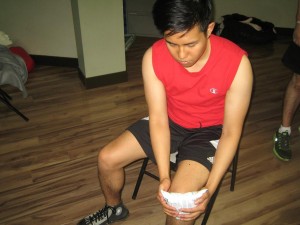Patellar tracking disorder is a condition where the kneecap changes out of position as the leg is bent or straightened. The kneecap twists too far toward the outside portion of the leg. In some people, it twists toward the inside part of the leg. The knee joint is a hinge that joins the two bones of the lower leg with the thigh bone. The knee cap is located at the end of the thigh bone, and held by tendons on the top and bottom, and on the sides is held by the ligaments. A layer of cartilage lines the underside portion of the kneecap, and helps it to glide along the groove in the thighbone. When there is a problem in any of these parts found inside and around the knee, it can cause patellar tracking disorder.
[youtube url=”https://www.youtube.com/watch?v=isB1M8sUMEk” width=”220″]A patellar tracking disorder can be caused by the way the knee is shaped. Knee problems include a flat or small kneecap, knock-knee, an elongated patellar tendon or a superficial groove at the endpoint of the thighbone. The muscles found in front of the thigh which is the quadriceps are weak and out of balance. A loose or too tight ligaments, tendons or muscles can also cause a patellar tracking disorder. A damaged cartilage in the kneecap can also cause this condition. Individuals who are overweight, run, or play sports that require repeated movements like jumping, knee bending or by squatting can cause patellar tracking disorder.

People suffering from patellar tracking disorder have the following symptoms
- There is pain in the front portion of the knee, when doing squatting, jumping, kneeling, or using the stairs.
- When bending or straightening the knee, there is a popping, grinding, slipping sound in the kneecap. A feeling that the knee is buckling out or giving away.
- If the knee is completely dislocated, there is severe pain and swelling, and the knee looks like a bone that is out of place, and it cannot be bent or straightened.
Treatment of the patellar tracking disorder
These are the first aid measures in order to reduce the pain and to strengthen the muscles around the knee cap and helping it to stay in place and if there is no severe pains or signs of dislocated kneecap.
- Take a rest from actions that causes pain in the knee like kneeling, squatting, jumping and running.
- Apply ice on the knee, before and after an activity. After 2-3 days, apply heat if it helps.
- Take an over-the-counter pain reliever like ibuprofen or naproxen in reducing the swelling.
- If the knee pain starts to reduce, do some exercises to increase the strength and flexibility in the leg and hip. A physical therapist plans the exercise program.
- Put tape on the knee to help hold the kneecap in place
- Use a knee brace for extra support for the knee
- Avoid doing movements that make the symptoms worse.
- Keep doing the stretches and strength exercises every day and try losing excess weight, if the person is overweight.
A patellar tracking disorder can be prevented by avoiding activities that overloads and overuse of the knee. Keep the muscles around the knees and hips strong and flexible. Stretch the legs and hips before and after an activity must be performed. Cycling and swimming are good activities for the legs and staying in a healthy weight to reduce stress on the knees.
